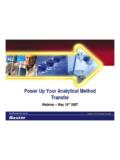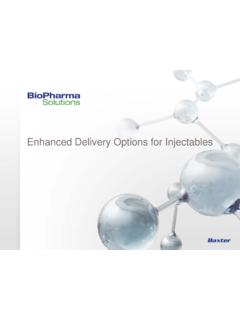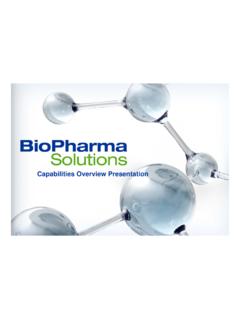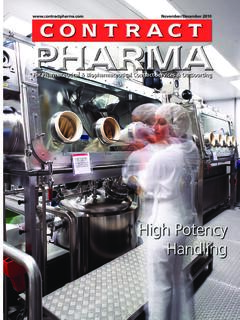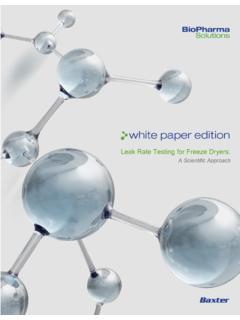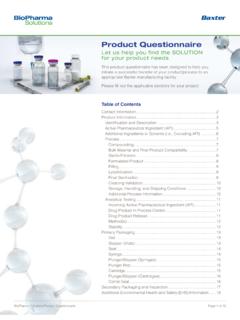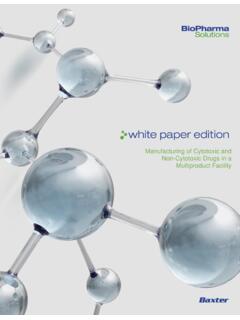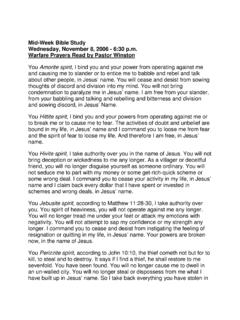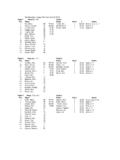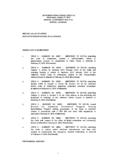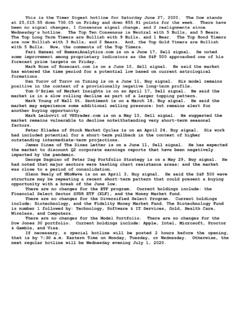Transcription of Complimentary WEBINAR Wednesday, December …
1 ISOLATOR TECHNOLOGY Speakers:Frank GenerotzkyCorinna SchneiderComplimentary WEBINARW ednesday, December 12, 2007 This WEBINAR presents the methods used at Baxter s Halle, Germany facility for the design and validation/qualification of isolators used for the aseptic production of sterile drug Frank Generotzky is recognized as an expert in the field of aseptic manufacturing of parenteral products, and is a frequent presenter at several European Conferences and ISPE Meetings for Sterile Drug Manufacturing. He earned his Diploma for Pharmaceutical Engineering from the University of Applied Science Lippe / H xter in Germany. Since 1996 Frank has designed and installed several production-lines in standard Cleanroom Technology as well as in Isolator Technology at Baxter s facility in Halle, Germany. Starting in 2001 Frank headed the production department for sterile cytotoxic drugs (liquid, powders andlyophilisates).
2 In his present role, Frank is responsible for the strategic development of Pharmaceutical Technology in Halle. He is leading a team of 13 engineers, who design, plan and realize the investment projects in Halle according to customer and market requirements. Frank GenerotzkyDirector of Technology and EngineeringMs. Corinna Schneider, is recognized as an expert in the field of sterile drug products produced by aseptic processing. She developed and implemented a complex VHP sterilization process for isolators and equipment parts in Halle/Germany and presented this method at pharmaceutical conferences and workshops in Europe and in the US. She trained local regulatory inspectors in VHP cycle development and presented her concept several times to the FDA. Ms. Schneider earned her Diploma for Pharmaceutical Engineering from the University of Applied Science Lippe / H xter in Germany. From 1995 to 2000 she headed the Microbiological Quality Control Lab and focused on environmental monitoring, validation of aseptic processing, and microbial identification.
3 In her current position in Quality Assurance she is responsible for GMP compliance, internal and external auditing, and several compliance projects to improve the effectiveness of the quality management SchneiderQA Specialist GMP Compliance3 TopicsIsolator Design Criteria- Different Isolator Applications- Process DevelopmentQualification of critical Design Features- Airflow Investigation Near Mouseholes- Isolator Integrity- VHP SterilizationIsolator Technology versus Conventional Cleanroom4 Designing Isolators5 Different Isolator ApplicationszIsolators for compounding and Sterilizable isolators for handling of toxic powderaseptic processingzNegative pressure isolators Positive pressure isolators (-50 Pa to -150 Pa)(25 Pa to 100 Pa) ISOLATORISOLATORzIsolator for manual sterile Isolators on automatic operations filling machines => Closed Isolators => Open Isolators 6 Different Isolator Applications Requirements on Containment IsolatorszGenerally operated under negative pressure to ensure max.
4 Operator safetyzTypically classified as ISO 7 (Class 10,000 at rest, Grade C)zThey must not exchange air with the surrounding environment(except through a HEPA filter)zEquipped with nitrogen supply if requiredzAll materials exiting the isolator must be cleaned or contained zThey must be cleanable in a reproducible and quantifiable manner;swab-tests and tracer substances should be used during qualification 7 Different Isolator Applications Containment Isolator for Compoundingznegative pressure of -100 Pa, electronically controlled zinterlocked isolator door after start of operationzvisual display indicates permanent status of the isolatorzradii in the isolator chamber >15 mm, chamber and fittings require gradient of 2 %ztightness test before each processzglove test prior to manufacturingz push push system for exhaust air filterszintegrated rapid transfer ports (RTP) for loading and discharging without compromising the surrounding 8 Different Isolator Applications Requirements on Isolators for Aseptic ProcessingzThey must not exchange air with the surrounding environment except when that air passes though a HEPA filterzTypically classified as ISO 5 (Class 100, Grade A)
5 ZThese units are typically operated under positive pressure and are subject to sterilization procedures prior to use zThey must be sterilized in a reproducible manner (VHP)zAll materials that enter the isolator must be sterilized and must enter either directly through a decontaminating or sterilizing system or via a rapid transfer port 9z Closed Box with HEPA filter H14zdiscontinuously loading and dischargingzall transfer processes are conducted via aseptic connections (RTP, SIP)Different Isolator Applications Closed Isolator for Aseptic OperationsExample: Isolator for Aseptic FillingzIsolator: - Grade A, (ISO 5)- VHP sterilization - positive pressure (+ 100Pa)z Double Door port-system for aseptic discharging of the isolator10 GGInspektionsmaschineInspektionsmaschine 3+42560 VialsInspektionsmaschine2540 Inspektionsmaschine 1+ uleAndockstationf r Isolator Applications Open Isolators for continuous Aseptic Operations11 Different Isolator Applications Open Isolators for continuous Aseptic OperationszContinuous supply with materials during operation, while maintaining Grad A ISO 5zUnidirectional airflow of m/s (+/- )zSafety features:- double wall design - filtration of recirculated air- pneumatic gaskets (controlled and alarmed) - CIP for containment and air ducts- emergency mode including pressure reversal uleAndockstationf r Pa10 Pa30 Pa30 PaISO 5 ISO 5zClassifications:Filling:ISO 5 / Grade ACapping: ISO 7 / Grade CSupport Area.
6 ISO 8 / Grade DzVHP sterilization for ISO 5 / Grade A- stopper bowls included in VHP sterilization- CIP / SIP for filling equipmentzCaps and capping equipment:- no sterilisation- controlled disinfectionzEnvironmental Monitoring:- particles m, m - viable air monitoring -surfaces (RODAC)- Temp, diff. pressure, relative humidity10 Pa 10 Pa ISO 7 ISO 7 Different Isolator Applications Open Isolators for continuous aseptic Operations40 Pa 40 Pa ISO 5 ISO 54 Pa4 Pa13 ZentralanlagevonH13H13H14max. 2 x m /h( w hrend Bel ftung nach VHP - Zyklus )LuftaufbereitungM + P(inkl. VHP-System)U15U15U15U15U15"Safe change""Safe change" ber DachAbluftUmluftPlenumZwischendeckebegeh barTechnikebene(Tonnendach)Produktionsra umKlasse DRaum - VerteilerZentralanlagezur berdruck im Isolator 30 PaH13"Safe change"ZentralanlagezurDifferent Isolator ApplicationsExample: Design HVACzIsolators should be equipped with independent HVAC systems14 Configuration of an Isolator15 Mock-Upand Risk AnalysisProcess IPC / Monitoring Qualification / Validation Cleaning CIP Reinigung Isolatoren und produktb.
7 Teile Temperatur, Druck Reinigungszeit R ckst nde Reinigungseffizienz Changeover Abf llmaschine Justage Initiatoren Handschuhtest Beladen Isolatoren SOP s reproduzierbare Positionierung BeladungGrenzwerte f. Dichtigkeit Validierung BeladungGrenzwert Druckabf. Sterilisation von: - Stopfen - produktber hr. Teile- VHP Isolator Testrun Justierung Kalibrierung Filtertest SOP s Grenzwerte IPK Waage Formatbezogene Vorgaben zur Ma-schineneinstellung Leak tightness Integrit t Isolator Dichtigkeit SIP Grenzwert Druckabfall Zeit Qualifizierung der zul. Dichtigkeit Sanitization Sterilization Abf llmaschine (SIP) Isolator (VHP) Temperatur , Druck, Menge, Zeit, Differenz-druck Validierung der VHP Sterilisation und SIP Set-up Validation of aeptic processing and Cleaning Validation before start Abf llmaschine Ausr stung IPK MA Qualifizierung Qualifizierung Reinraums Manufacturing F llmenge Monitoring (physik.)
8 /mikrobiologisch) v (Luft) p (diff.), T (Luft) rel. Feuchte (Luft), 100% Inspektion Qualifizierung der Transfersysteme 16-determination of the size; use 1:1 drawings of all machines in the isolator-simulate loading (tools, agar, probes ..)-determine positions for particle counting and viable air monitoring-determine ports for validation purpose (t, p, rel. humidity, NIR, filter integrity ..) -determine position for gloves carefully-define interfaces for HVAC, media, computer-systems, supplier of filling-machine ..-use CIP / SIP where ever possible, reduce manual handlingSimulation of all operations in the isolator-change of product contacting parts-simulate monitoring-adjustment of sensors or leadings-solve technical problems (jam of vials or stoppers ..) Process DevelopmentMock-up Study (Model Scale 1:1)17 Qualification of an Isolator18 Qualification of critical Design Features Isolators require a high level of qualification and validation with focus on:zAirflow Investigation Near MouseholeszIsolator IntegrityzVaporised Hydrogen Peroxid (VHP) Sterilization19 Inspectional Findings: Isolator Qualification(R.
9 Friedmann & J. Agalloco*)zDynamic filling line conditions not evaluated. Filling line was not in operation during smoke studies. zSmoke studies did not evaluate the pressure changescaused by introducing a glove into the isolator, or retrieving the glove from the isolator. zThere was no data documenting isolator airflow parameters, such as air pressurization and velocities, during smoke studies. The acceptability of the lower air pressure limit was not evaluated. * Presentation by R. Friedman & J. Agalloco; Agallaco & Ass., NJ 2004 20zIn this test a concentration of particleswith a mean size of approximately m is generated within 5-10 cm of the isolator opening. zThe particle concentration should be in the range of 100,000-1,000,000 per m . zAn electronic particle countercalibrated to the m particulate size is used to scan the opening from inside the isolator. The particle counts observed on the isolator sideof the opening should not be significantly different from the background countat the same location.
10 In the measuring location (critical region) the number of particles per unit volume should be less than of the initial challenge level to assure absence of airborne microbial contamination under routine operational A+30 PaGrade C+10 PaQualification of Isolator Integrity near MouseholesPDA TR 34 Appendix B L-R Method21 Isolator Integrity Leak-Testing zPressure Hold Test - positive pressure isolators - Test pressure: operating pressure x 2- less than of the total volume of the isolator per hour is acceptablezPressure Drop Test - negative pressure isolators- Test pressure: -200Pa - max. 50 Pa rise of pressure 6 min is acceptablezGloves (Hypalon mm): - Test pressure: 500 Pa after stressing the glove - less than 50 Pa in 4 min- supported by physical / microbial qualifications and trend analysis22z The VHP decontamination studies for the isolator did not provide an adequate challenge of the cycle to determine the weak points of VHP distribution/ penetration( , where air flow is most variable or potentially compromised).
